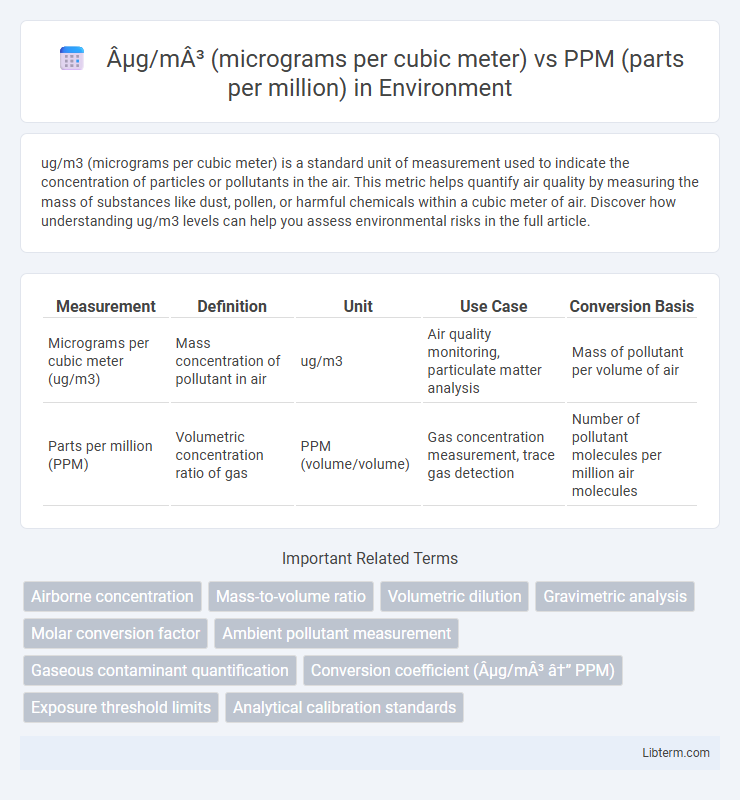ug/m3 (micrograms per cubic meter) is a standard unit of measurement used to indicate the concentration of particles or pollutants in the air. This metric helps quantify air quality by measuring the mass of substances like dust, pollen, or harmful chemicals within a cubic meter of air. Discover how understanding ug/m3 levels can help you assess environmental risks in the full article.
Table of Comparison
| Measurement | Definition | Unit | Use Case | Conversion Basis |
|---|---|---|---|---|
| Micrograms per cubic meter (ug/m3) | Mass concentration of pollutant in air | ug/m3 | Air quality monitoring, particulate matter analysis | Mass of pollutant per volume of air |
| Parts per million (PPM) | Volumetric concentration ratio of gas | PPM (volume/volume) | Gas concentration measurement, trace gas detection | Number of pollutant molecules per million air molecules |
Introduction: Understanding Air Quality Units
Air quality measurements use ug/m3 to quantify the mass of pollutants like particulate matter in a cubic meter of air, providing a direct indication of concentration by weight. PPM measures the ratio of pollutant molecules to the total air molecules, suitable for gases such as carbon monoxide or ozone. Understanding the distinction between ug/m3 and PPM is crucial for interpreting environmental data accurately and assessing health impacts.
What is µg/m³ (Micrograms per Cubic Meter)?
ug/m3 (micrograms per cubic meter) measures the mass concentration of a substance in air, representing the weight of particles or pollutants per cubic meter of air. This unit is essential for quantifying particulate matter like PM2.5 or PM10 in environmental monitoring and air quality assessments. Unlike PPM (parts per million), which counts the number of molecules relative to air molecules, ug/m3 provides a direct measurement of pollutant mass in the atmosphere.
What is PPM (Parts Per Million)?
PPM (parts per million) is a unit of measurement that expresses the concentration of a substance in air or solution, representing one part of a chemical per one million parts of the total volume. It is commonly used to measure trace gases or pollutants in the atmosphere, enabling precise comparison of contaminant levels. Unlike ug/m3, which quantifies mass per volume, PPM focuses on the ratio of molecules and varies with temperature and pressure conditions.
Key Differences Between µg/m³ and PPM
ug/m3 (micrograms per cubic meter) measures the mass concentration of a substance in air, reflecting the weight of particles or molecules per volume, making it essential for assessing air quality and particulate pollution. PPM (parts per million) quantifies the volume or mole fraction, indicating the number of pollutant molecules per million molecules of air, commonly used for gases and vapors in industrial and environmental monitoring. The key difference lies in ug/m3 providing a mass-based measurement sensitive to molecular weight, while PPM offers a dimensionless ratio focused on molecular count, requiring conversion factors for accurate comparison.
When to Use µg/m³ vs PPM
Use ug/m3 to measure the concentration of airborne particulate matter and pollutants when precise mass-based quantification is required, especially for health and environmental standards. PPM is ideal for gas concentration measurements where volume ratios are more relevant, such as in industrial gas monitoring or indoor air quality assessments. Selecting ug/m3 versus PPM depends on whether the focus is on particle mass concentration or volumetric gas concentration for accurate exposure evaluation.
Conversion Methods: µg/m³ to PPM and Vice Versa
Conversion between ug/m3 and PPM requires knowledge of the pollutant's molecular weight and the temperature and pressure conditions, as the relationship depends on the ideal gas law. To convert ug/m3 to PPM, use the formula PPM = (ug/m3 x 24.45) / molecular weight at standard temperature and pressure (25degC, 1 atm). Conversely, converting PPM to ug/m3 involves the equation ug/m3 = (PPM x molecular weight) / 24.45, where 24.45 represents the molar volume of an ideal gas in liters.
Factors Affecting Unit Selection
Factors affecting the selection between ug/m3 and PPM include the substance's molecular weight, temperature, and pressure since ug/m3 measures mass concentration while PPM represents a volumetric ratio. Environmental conditions like humidity and gas composition influence the accuracy of PPM measurements, especially for gases with variable densities. Regulatory standards and industry-specific requirements also dictate which unit provides more relevant exposure or pollution level data for health risk assessments.
Application in Air Pollution Monitoring
ug/m3 (micrograms per cubic meter) measures the mass concentration of pollutants like particulate matter (PM2.5, PM10) and is crucial for assessing air quality health risks, especially in regulatory standards. PPM (parts per million) quantifies the volumetric concentration of gases such as ozone (O3), carbon monoxide (CO), and nitrogen dioxide (NO2), enabling accurate monitoring of gaseous emissions and compliance with environmental guidelines. Both units are essential in air pollution monitoring, with ug/m3 providing direct mass-based exposure levels and PPM offering relative gaseous concentration, facilitating comprehensive environmental assessments.
Health Implications Based on Measurement Units
Micrograms per cubic meter (ug/m3) measures the mass concentration of airborne pollutants, directly correlating to health risks by indicating the amount of particulate matter inhaled per volume of air. Parts per million (PPM) quantifies the volumetric concentration of gaseous substances, helping assess exposure levels to toxic gases affecting respiratory and systemic health. Understanding the differences between ug/m3 and PPM is crucial for accurately evaluating pollutant impacts on cardiovascular, pulmonary, and neurological functions based on precise exposure metrics.
Conclusion: Choosing the Right Unit for Air Quality Assessment
Selecting the appropriate unit for air quality assessment depends on the pollutant type and monitoring purpose; ug/m3 is ideal for measuring particulate matter concentration since it reflects mass per volume, while PPM is suitable for gaseous pollutants as it represents volumetric ratio. Regulatory standards and health guidelines often specify thresholds in either ug/m3 or PPM, emphasizing the importance of using the unit aligned with the pollutant's physical characteristics and exposure risks. Accurate interpretation of air quality data requires understanding these units to ensure compliance and effective environmental management.
µg/m³ (micrograms per cubic meter) Infographic

 libterm.com
libterm.com